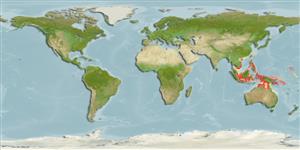>
Acanthuriformes (Surgeonfishes) >
Ephippidae (Spadefishes, batfishes and scats)
Etymology: Rhinoprenes: Greek, rhinos = nose + Greek, prenes = the front part of a body (Ref. 45335).
Environment: milieu / climate zone / depth range / distribution range
Ökologie
seewasser; brackwasser demersal. Tropical
Western Pacific: Papua New Guinea to northern Australia.
Size / Gewicht / Alter
Maturity: Lm ? range ? - ? cm
Max length : 15.0 cm TL Männchen/unbestimmt; (Ref. 245)
Rückenflossenstacheln (insgesamt) : 8; Rückenflossenweichstrahlen (insgesamt) : 19 - 20; Afterflossenstacheln: 3; Afterflossenweichstrahlen: 16 - 17. Body deep and compressed, quadrangular in outline. Mouth small and inferior. Second dorsal spine, fourth pectoral ray, and first pelvic ray greatly prolonged into free filaments which reach tail base or beyond. First dorsal-fin spine, fourth pectoral-fin ray, and first pelvic-fin ray greatly elongated filaments, reaching to or beyond vertical line at rear end of dorsal-and anal-fin bases. Head naked. Mouth inferior, the snout and upper jaw projecting in front of lower jaw (Ref 43039).
Feeds on algae and sewage (Ref. 4537).
Life cycle and mating behavior
Geschlechtsreife | Fortpflanzung | Ablaichen | Eier | Fecundity | Larven
Nelson, J.S., 1984. Fishes of the world. 2nd edition. John Wiley & Sons, Inc., New York. 523 p. (Ref. 245)
IUCN Rote Liste Status (Ref. 130435: Version 2024-2)
Bedrohung für Menschen
Harmless
Nutzung durch Menschen
Fischereien: nicht kommerziell
Tools
Zusatzinformationen
Download XML
Internet Quellen
Estimates based on models
Preferred temperature (Ref.
123201): 26.9 - 28.8, mean 28 °C (based on 232 cells).
Phylogenetic diversity index (Ref.
82804): PD
50 = 1.0000 [Uniqueness, from 0.5 = low to 2.0 = high].
Bayesian length-weight: a=0.02692 (0.01132 - 0.06402), b=2.94 (2.74 - 3.14), in cm total length, based on LWR estimates for this (Sub)family-body shape (Ref.
93245).
Trophic level (Ref.
69278): 2.0 ±0.00 se; based on food items.
Widerstandsfähigkeit (Ref.
120179): hoch, Verdopplung der Population dauert weniger als 15 Monate. (Preliminary K or Fecundity.).
Fishing Vulnerability (Ref.
59153): Low vulnerability (10 of 100).
